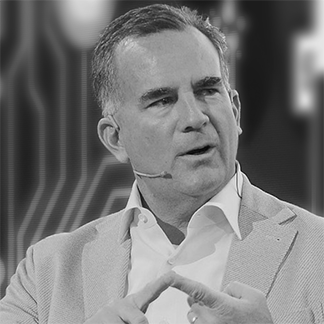
Oracle Digibook: Change Management in the Cloud
How to Lead Business Transformation
Nimble technology frameworks support a culture that embraces continuous change
In an age when rapidly developing technology is driving seismic change and disruption, businesses are faced with a stark choice: embrace the accelerated pace of change or risk succumbing to it. Cloud technology — itself a primary source of disruption — offers organizations at any maturity level a platform for successful transformation and sustained growth. The keys to success are two-fold:
First, organizations must have a clear understanding of their long-term strategies.
Second, they must choose a comprehensive solution that establishes a solid foundation for agile growth.
Business transformation begins with digital transformation, but it doesn't end until you've fostered an agile culture that brings fresh solutions to business challenges. (In fact, it may never end: The need to continuously change simply carries on!)
Sound overwhelming? It doesn't have to be. We asked eight of our experts to weigh in on this complex topic. Each of these experts has led transformation in global organizations, assisted Oracle customers in leading transformations of their own, or both. Together, they cut through the noise surrounding business transformation and provide a roadmap your organization can follow.
Introducing the Experts
What is Business Transformation?
Isn't transformation just another word for change? Not quite, says Daryl Szebesta, VP, Cloud Transformation. The difference is a matter not just of scale, but intent. "Change is constant," he says. "I suppose when it gets to a certain size, people would constitute it as transformation. But the better definition is that in transformation, businesses are fundamentally changing the way they operate as opposed to just the evolutionary change, which is constant." Andy Campbell, HCM Strategy Director, adds, “Transformation is an orchestrated effort to change strategy, process, policy, organizational structure, vendor agreements and technology concurrently. It is radically different from evolutionary change.”
Beyond this broad definition, however, transformation is unique to each organization. "Transformation can mean a lot of things depending whom you talk to and at what stage of the journey they are on," says Juergen Lindner, VP of Product Marketing ERP. "It always needs to be contextualized around their company and industry."
The Challenges
There are two types of challenges to consider when discussing transformation: external and internal.
External Challenges
- Rapid technological development and disruption
- The growing power of the digital consumer
- Lower barriers to entry across industries
- An increasingly competitive global business environment
Internal Challenges
- Difficulty implementing cutting-edge technology to enable business innovation
- Cultural resistance to change
- The need to deliver and measure value at every level of the organization
Straddling both internal and external challenges is the vast amount of data that organizations collect, maintain, and analyze. "We're living in an increasingly data-driven world where we're bringing together disparate datasets to create bigger value and bigger understanding about their customers," says Toby Baker, Solution Consulting Director, Oracle Marketing Cloud, EMEA. Compounding the data challenge is that of replacing incomplete, inaccurate, or irrelevant data with valid information.
Disruption is ongoing, so transformation must be continuous. This is the biggest challenge and one that continues to accelerate. "There's a massive amount of disruption in the business, not just new competitors within the same industry, but from other industries entirely," explains Andy Campbell, HCM Strategy Director. Adapting to disruption is at the heart of transformation.
Expectations are set by customers, not competitors. The pace of technological change has put incredible power into the hands of customers, who have come to expect instant gratification in every aspect of their relationship with companies. "The customer is in the strongest position they've ever been from a global market point of view," says Frank Seminaro, Senior Director, Product Marketing. "They can demand what they get, as well as when and how they get it."
This trend began within the B2C world, but is rapidly driving B2B interactions as well, Baker explains. "Experience starts to become the primary factor in people's decision-making process about who they're going to do business with," he argues. "By 2020, customer experience will transcend product and price as the key differentiator within organizations, and that's from a business-to-business and a business-to-consumer perspective. And in some areas we are already seeing this today."
Business opportunities can't wait for traditional IT turnaround. Developing on-premises technology to support a business objective can take months. That level of turnaround now means that by the time the solution is ready, the objective or need may have changed. "Business and IT have never really been a match made in heaven," says Szebesta. "IT hasn't been able to operate with agility, which frustrates businesses." At the same time, however, the rapid pace of technological change has created a paradox: Even as companies struggle to develop the technologies needed to enable business objectives, innovative technologies are coming online that render many business processes obsolete. "The challenge used to be finding the technology to support business goals," says John Shorter, VP of ERP Transformation. "But that has been turned on its head."
Innovation "around the edges" is no longer enough. In response to these forces, many companies implement technological change within a single business or functional unit, or even just at the customer-facing level. These limited and disconnected efforts can have the undesired outcome of "fencing in" new technology without supporting organization-wide, end-to-end transformation. "The reason you do a digital transformation is to connect your enterprise and make it more responsive to change," Shorter says. Baker makes the case more bluntly: "A seismic shift in culture requires a technological shift of equal magnitude."
There's no such thing as "just" a support function. In a highly competitive global landscape, so-called support functions such as IT or HR must pull their own weight as value creators. Other functions like sales and finance have made the transition and are now continuously improving, and IT and HR must follow. "We're seeing a push toward workforce analytics beyond just focusing on HR processes," says Campbell. "People are asking how HR can enable changes in any process across the organization to create more value, drive more revenue, or create more efficiency in the overall business."
Technological transformation is just the beginning. The greatest challenge facing organizations seeking transformation is not just the technology, but culture. "I see culture as the biggest barrier to digital transformation," says Reggie Bradford, SVP, Startup Ecosystem and Accelerator. "Don't get me wrong — innovative technologies are essential. But true business transformation means transforming the culture itself, and that takes real leadership."
Baker agrees, adding that the culture in question must focus on the customer. "Of all the barriers within an organization, culture is probably the biggest," he says. "We hear a lot about how culture eats strategy for breakfast, but in the case of customer focus it's absolutely true."
Cloud Technology Sets the Foundation
To address these transformational challenges, companies need a technology solution that permits rapid design, adoption, and adaptation, that frees resources for creating competitive differentiation and value, and that can be easily and economically deployed and scaled. That technology is cloud.
"The rise of cloud technology has created an inflection point in the marketplace that has enabled organizations to take on larger-scale change," says Szebesta. "Until the advent of the cloud, companies didn't have the capability to instigate the level of change that we needed."
Here's What Cloud Technology Has to Offer 
Best practices are built in. Best-in-class cloud ERP, HCM, CX, and SCM solutions leverage best practices by design, meaning that your organization can focus its resources on what differentiates it from the competition, without continuously reinventing internal business processes. "Customizing ERP, HCM, or even customer experience platforms is not what differentiates a business, and if you start to go down that road, it actually slows you down as a business and makes you less competitive," argues Szebesta. "I've seen organizations in which the extent of software customization had paralyzed the business altogether."
At the same time, Campbell notes, the ideal cloud solution is flexible enough to adapt to processes that are competitive differentiators. He cites the example of HCM: "There are competitive differentiators in the HCM space, particularly on the recruitment and talent management fronts. The beauty of a flexible cloud platform is that it can be tailored to the unique needs of businesses without traditional code customizations."
A holistic approach. Enterprise cloud solutions are uniquely suited to fully integrated, end-to-end architectures that function across organizational boundaries, even at the customer-experience level. They can be as complex and interoperable as needed, without generating the maintenance overhead of on-premises solutions or even limited-functionality cloud apps from multiple vendors. "There are no boundaries in the business process, so why should there be in your go-to-market?" asks Cara Capretta, VP, HCM Transformation and Thought Leadership Practice. Adds Shorter, "The reason digital transformation drives business transformation is that it connects all parts of the organization together. This makes the business highly responsive to changes in the environment."
End-to-end supply chain management. Even as cloud solutions connect organizations, processes, and functions internally, they are the ideal platform to unite the supply chain from vendor to customer as well. They are particularly suited to the buyer-centric supply-chain design that has transformed entire industries. "Look at companies like P&G, or Apple," argues Seminaro. "Their end-to-end supply chains are their defining business operating models. This is even starting to dominate life sciences, where the concept of patient-centric design is transforming healthcare end to end."
Scalability. It makes sense for large organizations to begin transformation on a smaller scale as proof of concept before moving on to a broad-based deployment. But as we've seen, many companies stop there, stymied by functional and operational silos and a lack of a vision for holistic transformation. Cloud solutions are built for scalability, permitting companies to tap in to a handful of instances and processes or an entire organization's worth without continually adding infrastructure or new vendors. "This allows companies to develop a plan, test assumptions, guide the change, and create a roadmap for transforming the end-to-end business," Seminaro says.
Drastically reduced deployment time. Whether creating new products or streamlining business processes, speed counts. "[At GE] it would take about three to four years to get the business to adopt a new platform and process, because the technology took a long time to set up," Shorter explains. With the cloud, however, the infrastructure is already built and ready to deploy. "Typical deployment today in the cloud is three months," he adds. In fact, Capretta notes, once the organization moves to the cloud, many aspects of configuration and management can be handled by business functions themselves. "The cloud is more configurable and easier to manage," she says. "HR functions can do it on their own."
More resources for innovation. Because the cloud requires significantly fewer IT resources, consultants, and personnel to deploy and maintain, your team can focus on creating real competitive differentiation. “Cloud can be a catalyst to free your key players and your IT department from the typical upgrade cycles,” Lindner says. “You can then dedicate this additional capacity toward innovation and differentiation.” A comprehensive cloud solution provides the technology platform to support this bimodal approach at the lowest cost and shortest time-to-deploy, Baker says. “It offers both steady state to maintain business continuity, as well as agile methods to prototype, deploy and re-iterate quickly.”
A trusted partner. Finally, cloud computing providers are highly incentivized to offer best-in-class customer service and continuous product improvement. “Cloud is a service model,” Campbell argues. “If we don't provide the service that the customer expects, the likelihood that they will switch is much, much higher than in the past.” Businesses, he concludes, should evaluate their cloud providers as potential long-term partners. “The questions then become: Do I have the right partner? Are they developing in the right way? Do they have the right vision for the future work that aligns with where I think I want to be in three years?” Furthermore, a single-vendor approach means the business’s needs come first. “Take the example of upgrades,” Szebesta offers. “Each enterprise has its own critical operational dates, and the cloud vendor must work with the enterprise to minimize operational risk.” And finally, an experienced partner can help your organization answer the question, Where do we start?
What is Needed?
Cloud is the technology solution that will drive and enable ongoing business transformation. But as we've made clear, technology is just one component of transformation, and in many ways, it's the easier one. "When you ask anyone who has been involved in a big digital transformation, they always say that the hardest part was not the technology, it was the change management," Capretta points out.
The keys to fundamental business transformation, then, lie not just in establishing a culture that embraces the initial transformation, but also in leading and managing ongoing change.
What Your Company Needs to Succeed 
Leadership. There's no two ways about it. Without sponsorship at the highest level, business transformation is unlikely to succeed. "It takes seamless leadership and execution, and everybody has to be rowing in the same direction," explains Bradford. "Leadership has to embrace it. They have to walk the walk and talk the talk. It truly requires commitment." Adds Shorter, "This is not something you can hand off to a consultant." Indeed, the transformation should be one of the company's top priorities during its deployment. "It is paramount that the entire management team becomes well-versed in digital technologies," says Lindner. "The ‘digital IQ' needs to be raised across the entire organization."
Cooperation. In most organizations, the responsibility for this education falls on the CIO's shoulders. "CIOs should really be called BEOs, Business Enablement Officers," Szebesta suggests. "Rather than being the guardian of IT, the CIO should be creating solutions that allow a business to achieve its desired outcomes." That requires a deeper understanding of each business unit or function than CIOs have needed in the past. "The challenge is to give a very specific value for each individual member of the C-suite," he concludes. This has already become a best practice among the most successful organizations, Seminaro notes. "When companies like P&G review projects at the end of the year, a team including the business leader, the process owner, IT owner and people owner report how much money and value they actually added to the business, not whether they just completed the project on budget and on time."
Clear business objectives. Though critical, technology is still just an enabler of business goals and objectives. It is crucial, then, that everyone understands and is aligned to those objectives before considering and choosing the technology that is needed. "Hopefully, most of the decisions that are being done by the executive team are rooted not just in technology-based discussions, but in broader, business outcome-driven discussions," Lindner says. "Where do we want to go? Where do we want to take the company in the next couple of years? Technology then becomes the critical enabler to make it happen."
A strong key-user network. Many of our experts raised the notion of uncovering and nurturing a network of key users representing regions, functions, and business units across the organization to help develop the program initially and later to evangelize its benefits to their peers. "If I were to lead a transformation today, based on what I've learned working with customers, I would have community groups be part of the implementation," Capretta says. "I would create groups that include tenured employees, newer employees, high-potential employees, and representatives of advocacy groups. I would have them consider how the parts of the system come together. I would leverage their credibility as evangelists in videos and training sessions. I would personalize the deployment to the ‘nth' degree and let people in real jobs own it."
Cultural change. The final step is not a step at all, but a broad-based cultural shift toward greater agility to fully leverage the capabilities of the technological transformation. Success means building and continuously adapting new competitive capabilities. "Larger companies should embrace the ‘startup' philosophy of taking risks, of encouraging your employees to embrace risks, to fail fast and to do whatever it takes to delight a customer," Bradford says, noting that the landscape is littered with the shells of once-great companies, such as Blackberry and Kodak, that failed to adapt quickly enough. Baker sees an opportunity to create a culture that innovates and executes equally well. "Creativity and innovation skills are almost polar opposites to the skills you need for execution," he explains. "Creating a culture that accepts both of those sides and integrates them into a creative and executing organization is key." This, Seminaro argues, goes beyond change management. "You can't simply ‘manage' change," he says. "Rather, you can lead and manage change in an organization. What you're asking the organization to do is to work differently, for people to play different roles and, often, for leaders to develop and enhance new skills."
Taking the Next Steps
Change is inevitable, and business transformation is a choice that remains in the hands of every organization, and especially its leaders.
The first step toward transformation is developing a clear understanding of your customers and their changing behaviors. Set audacious goals based on one key goal: delighting your customer.
Next is a clear-eyed assessment of your organization's current technology — particularly its capacity for future growth and agility.
And finally, map the options and routes to transformation while ensuring you have the leadership drive to execute and overcome barriers.
By implementing a cloud-based digital transformation, you're providing your company the speed, agility, and end-to-end integration to support its organizational transformation.
To learn more about how Oracle's ERP, HCM, CX, and SCM Cloud Solutions can drive your company's transformation, get in touch:
Copyright © 2017, Oracle and/or its affiliates. All rights reserved. Oracle and Java are registered trademarks of Oracle and/or its affiliates. Other names may be trademarks of their respective owners.
Contact Us
- US Sales +1.800.633.0738
- Have Oracle Call You
- Global Contacts
- Support Directory







